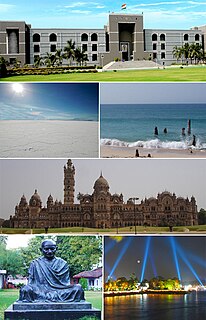
In rail transport, track gauge or track gage is the spacing of the rails on a railway track and is measured between the inner faces of the load-bearing rails.

The gauge for the most of the China national railway network is standard gauge. Currently, in the national railway network, only the 1,000 mmmetre gauge Kunming–Hai Phong Railway uses narrow gauge. In addition, there are some industrial lines still using narrow gauge, mostly 2 ft 6 in narrow gauge or 600 mm narrow gauge. As of 2003, 600+ km narrow-gauge railways, 50000+ km standard gauge railways, and 9.4 km broad gauge railways were in use in mainland China.
Rajputana–Malwa Railway was a 1,000 mm railway line which ran from Delhi to Ajmer and from Ajmer to Indore and Ahmedabad. It was earlier known as Rajputana State Railway until 1882 when it was renamed.

Gauge conversion is the change of one railway track gauge to another. This may be required if loads are too heavy for the existing track gauge or if rail cars are of a broader gauge than the existing track gauge. Gauge conversion may become less important as time passes due to the development of variable gauge systems, also called Automatic Track Gauge Changeover Systems.
This is list of former and actual narrow-gauge railways in India.

Katihar Junction railway station serves Katihar city in Katihar district in the Indian state of Bihar. The Katihar Junction railway station is connected to most of the major cities in India by the railway network.

Rangiya Junction railway station is a junction station on the New Bongaigaon-Guwahati section of Barauni-Guwahati line, and Rangia-Tezpur line of Rangia-Murkongselek section. It is located in Kamrup district in the Indian state of Assam. It serves Rangiya and the surrounding areas.
Oudh and Rohilkhand Railway was an extensive railway network in the North India, mostly north of the Ganges, starting from Benares and subsequently up to Delhi.

Porbandar railway station is a terminus station in the coastal city of Porbandar in the Indian state of Gujarat. It belongs to the Bhavnagar Division of Western Railways. It is one of the westernmost Broad gauge railway stations in India.
Jamnagar & Dwaraka Railway was a 1,000 mm metre gauge in the Nawanagar State in Gujarat during 19th century.
Porbandar State Railway was a 1,000 mm metre gauge in the Porbandar State in Gujarat during the 19th century.

The Delhi–Jaipur line connects Jaipur city with Delhi, the capital of India along the Jaipur railway division.
The Jodhpur–Bathinda line connects Jodhpur, in the Indian state of Rajasthan to Bathinda in the Punjab, via Dabwali Railway in Haryana. During the British Raj, Bathinda was on the Delhi-Karachi line and after independence and partition of India in 1947, it is on the Delhi-Fazilka line. This line operates under the jurisdiction of North Western Railway.
The Gondal State Railway (GSR) was a metre gauge railway owned by the Gondal State.
The Junagadh State Railway (JunSR) was a metre gauge railway owned by the Junagadh State and initially worked by the Bhavnagar–Gondal–Junagadh–Porbandar Railway. From 1911 the JunSR worked itself as an independent system, owned by the Junagadh Durbar, until 1948 when it became part of the Saurashtra Railway.

Kathiawar is a peninsula which today forms part of the Indian state of Gujarat. The peninsula covers an area of 23,345 sq. miles and in 1901 had a population of 2,645,805.
Kathiawar State Railway was a metre gauge railway built by the Kathiawar State. The railway opened in December 1880. The railway ran from Wadhwan on the south side of the Bhogavo River to the docks at Bhavnagar. It was also known as the Surendranagar–Bhavnagar Railway. This railway later merged with Bhavnagar State Railway.
The Jetalsar–Rajkot Railway was a metre gauge line in Gujarat. The line of 46 miles(72 km) connected Jetalsar to Rajkot and opened in 1893. The line was worked by the Bhavnagar–Gondal–Junagadh–Porbandar Railway (BGJPR) until 1911; and later by the Gondal–Porbandar Railway (GPSR)







